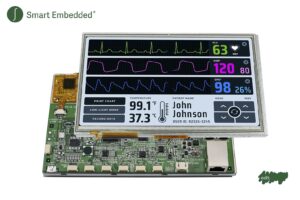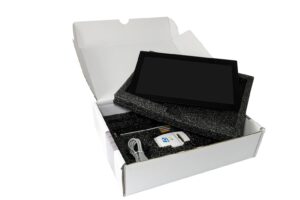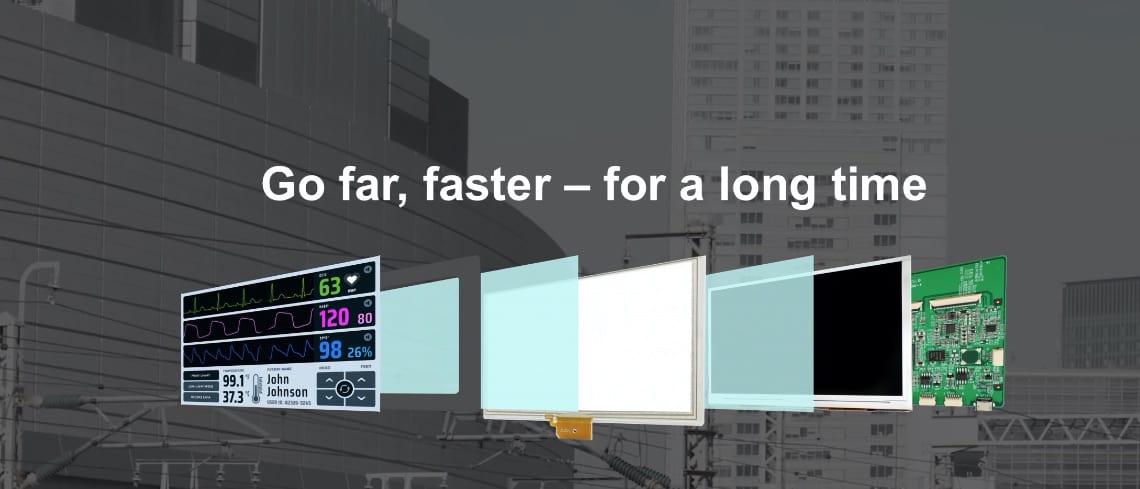To improve the accessibility of our content, please find the audio version of this blog post.
The Smart Embedded Display from EDT (Emerging Display Technologies), a member of the ST Partner Program, is a module that bundles an STM32F7 or STM32H7 MCU board, an industrial TFT display with a capacitive touch panel sensor as well as a cover lens, and a number of industrial interfaces, to offer a one-stop solution when designing an embedded system with a display. Before the world went on lockdown due to the COVID-19 pandemic, EDT showcased its Smart Embedded Display at Embedded World 2020, but as trade shows and live events are still mostly non-existent, we wanted to shine a light on what makes this platform an exciting proposition for engineers. Beyond the obvious hardware advantage of having a solution with all these components integrated, the video below shows how the module’s compatibility with TouchGFX, our framework for building GUIs, vastly accelerates developments.
The Smart Embedded Display comes in four flavors: 4.3 inches, 5 inches, 7 inches, and 10.1 inches, all of them ready to go to market, meaning that engineers don’t have to worry about tuning touch layers, solving complex hardware challenges, or sourcing parts from multiple vendors. Since EDT is first an LCD and touch panel company, their value proposition is about offering their technical expertise and know-how so teams can save time and resources. And to show what they can do, they made the Evaluation Kit, which includes one of the Smart Embedded Display, and an ST-LINK module probe, facilitating the programming and debugging of the MCU. We thus sat down with two representatives from EDT-Europe, Michael Melvang, Managing Director, and Paul Kleist, Director, Application & Design Engineering, to better understand how they came to offer their Smart Embedded Display.
Smart Embedded Display: Relying on STM32

As Michael and Paul explained, they started by surveying many of the principal actors in the industry before settling on an STM32, primarily because of its performance and ease of use. To start their prototyping phase as quickly as possible, they simply took an ST Discovery board and slapped their display onto it, thus quickly testing the fundamentals of their solution. As they shared:
“We started by using everything we could get from ST. For the first generation of our Smart Embedded Display, we heavily relied on ST’s schematics and drivers to save time and quickly release a solid foundation. We further customized our module when working on the second generation, but still started our project by opening STM32CubeMX to generate the header files that ended up setting the MCU’s pinout and clock tree as well as initializing the added Interfaces.”It was fascinating to learn that EDT chose an STM32 MCU because of ST’s commitment to product longevity. EDT has customers working in fields that are notorious for requiring long-term support, such as medical or industrial markets. They thus need the assurance that a component used ten years ago will still be available in the event of a repair, or if customers request it. Our decade-long commitment to our microcontrollers was, therefore, an essential aspect of their decision to use an STM32 because part of their value proposition is to offer a module with an exceptional lifespan. It is uncommon for a display maker to invest so much on the embedded system that will drive the graphical interface. EDT thus chose ST to ensure that they could offer the long-term assurances that are so dear to some of their customers.
Smart Embedded Display: Relying on TouchGFX

The Getting Started Guide for the Smart Embedded Evaluation Kit shows that EDT’s module heavily relies on TouchGFX. The company developed quite a few packages for TouchGFX Designer that enabled their clients to start working on a new user interface from a template. The idea is to lay the groundwork to get developments going quickly. For instance, users can start with various example interface, from flex buttons, keyboards, or text rotations, to only name a few, and focus on customizing the assets and animations, rather than begin from scratch. Additionally, because ST is in charge of both the MCU and the graphical framework, users benefit from a lot of hardware optimizations without lifting a finger, such as the use of the ChromART IP in STM32 MCUs to accelerate animations.
The Evaluation Kit includes a Project example that uses all the interfaces available on the module, from RS232, to RS485, CAN, I2C, SPI, GPIO, USB-OTG (CDC Class), and TCP/IP for the modules with Ethernet. Additionally, the Interface Guide documents the initialization of all these interfaces.
Smart Embedded Display: Relying on EDT
Our conversation with Michael and Paul was enlightening because they provided us with a great story about how they used ST technologies to lift their particular innovation. As they explained:
Our unique value to the industry is within the touch display. It’s in our ability to use optical bonding to improve readability in daylight, to tune the touch interface to ensure precision, even with wet fingers or while wearing gloves, and it’s in our ability to ship the module with a cover glass. However, to use this touch display, users need a proper MCU to power it and a graphical framework to take advantage of it. By using ST’s hardware and software, we can allow our innovations and expertise to shine brighter.Once teams have a final design, EDT also offers testing services to help determine its reliability and provide quality assurance. The company checks for performance in harsh conditions, such as high or low temperatures, humid environments, and against thermal shocks, among other things. It also tests for electromagnetic interferences in a special chamber and can offer recommendations. Additionally, since EDT certified its Smart Embedded Display with regulatory bodies across the globe, getting a certification for the final product will be more straightforward. EDT also offers customization and manufacturing possibilities with a production capability of up to one million units per year. Hence, having one partner and source from the beginning to the end of a project is reassuring and a testament to the power behind the Smart Embedded Display modules.
